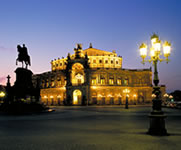Places of interest
The history of Goslar, a beautiful former imperial city situated at the northern edge of the Harz nature reserve, stretches back over a thousand years. Its distinctive skyline was once dominated by churches, chapels and numerous towers, and is still a stunning sight today. The steeples of its five large parish churches remain, and the view is best enjoyed from the Imperial Palace high above the town. Fascinating historical buildings are dotted around the marketplace with its fountain and carillon, while the ramparts and the sheer size of the Zwinger fortified tower impress even from a distance. Imperial Palace
No trip to Goslar is complete without a visit to the Imperial Palace. It was the jewel in the crown for the German emperors of the period, and the finest residence in their realm. Built between 1040 and 1050 during the reign of Heinrich III, the palace is a remarkable example of secular architecture. For two centuries, it bore witness to German and European history in the making at numerous imperial and court diets. Joined to the south of the palace is the Chapel of St. Ulrich, where the heart of Emperor Heinrich III, who died in 1056, lies entombed within a stone sarcophagus bearing his image. Market square
Overlooked by Marktkirche church with its two distinctive spires, Goslar's market square has historical buildings wherever you look. The central fountain marks the middle of the town, and is crowned by an eagle – the emblem of Goslar. Four times a day, all eyes and cameras are drawn to the old treasury building on the east of the square. High up on its gabled lucarne, three miniature doors open to reveal a procession of figures who tell the story of the Rammelsberg mines with a glockenspiel accompaniment. Zwinger fortified tower
Zwinger fortified tower is located on the southern edge of Goslar's old town. Built between 1517 and 1524, this 19-metre tower was once part of the town fortifications. With walls up to six metres thick and a diameter spanning an impressive 26 metres, it was one of the best-protected buildings in Europe at that time. During a siege, its four storeys could accommodate up to 1,000 men. Today, the castle houses a restaurant and the Museum of the late Middle Ages, which displays medieval weapons, instruments of torture and knights' armour.
No trip to Goslar is complete without a visit to the Imperial Palace. It was the jewel in the crown for the German emperors of the period, and the finest residence in their realm. Built between 1040 and 1050 during the reign of Heinrich III, the palace is a remarkable example of secular architecture. For two centuries, it bore witness to German and European history in the making at numerous imperial and court diets. Joined to the south of the palace is the Chapel of St. Ulrich, where the heart of Emperor Heinrich III, who died in 1056, lies entombed within a stone sarcophagus bearing his image.
Overlooked by Marktkirche church with its two distinctive spires, Goslar's market square has historical buildings wherever you look. The central fountain marks the middle of the town, and is crowned by an eagle – the emblem of Goslar. Four times a day, all eyes and cameras are drawn to the old treasury building on the east of the square. High up on its gabled lucarne, three miniature doors open to reveal a procession of figures who tell the story of the Rammelsberg mines with a glockenspiel accompaniment.
Zwinger fortified tower is located on the southern edge of Goslar's old town. Built between 1517 and 1524, this 19-metre tower was once part of the town fortifications. With walls up to six metres thick and a diameter spanning an impressive 26 metres, it was one of the best-protected buildings in Europe at that time. During a siege, its four storeys could accommodate up to 1,000 men. Today, the castle houses a restaurant and the Museum of the late Middle Ages, which displays medieval weapons, instruments of torture and knights' armour.
Travel Planner
Select an option...
Map of Germany
Hotels in Goslar
Loading



